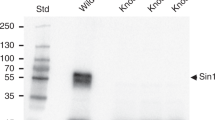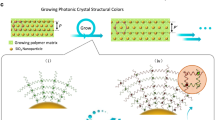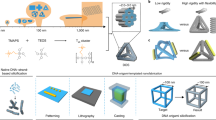Abstract
Diatoms are of interest to the materials research community because of their ability to create highly complex and intricate silica structures under physiological conditions: what these single-cell organisms accomplish so elegantly in nature requires extreme laboratory conditions to duplicate1,2—this is true for even the simplest of structures. Following the identification of polycationic peptides from the diatom Cylindrotheca fusiformis, simple silica nanospheres can now be synthesized in vitro from silanes at nearly neutral pH and at ambient temperatures and pressures3,4. Here we describe a method for creating a hybrid organic/inorganic ordered nanostructure of silica spheres through the incorporation of a polycationic peptide (derived from the C. fusiformis silaffin-1 protein) into a polymer hologram created by two-photon-induced photopolymerization. When these peptide nanopatterned holographic structures are exposed to a silicic acid, an ordered array of silica nanospheres is deposited onto the clear polymer substrate. These structures exhibit a nearly fifty-fold increase in diffraction efficiency over a comparable polymer hologram without silica. This approach, combining the ease of processability of an organic polymer with the improved mechanical and optical properties of an inorganic material, could be of practical use for the fabrication of photonic devices.
This is a preview of subscription content, access via your institution
Access options
Subscribe to this journal
Receive 51 print issues and online access
$199.00 per year
only $3.90 per issue
Buy this article
- Purchase on Springer Link
- Instant access to full article PDF
Prices may be subject to local taxes which are calculated during checkout



Similar content being viewed by others
References
Parkinson, J. & Gordon, R. Beyond micromachining: the potential of diatoms. Trends Biotechnol. 17, 190–196 (1999).
Morse, D. E. Silicon biotechnology: harnessing biological silica production to construct new materials. Trends Biotechnol. 17, 230–232 (1999).
Kröger, N., Deutzmann, R. & Sumper, M. Polycationic peptides from diatom biosilica that direct silica nanosphere formation. Science 286, 1129–1132 (1999).
Cha, J. N., Stucky, G. D., Morse, D. E. & Deming, T. J. Biomimetic synthesis of ordered silica structures mediated by block copolypeptides. Nature 403, 289–292 (2000).
Kirkpatrick, S. M. et al. Holographic recording using two-photon-induced photopolymerization. Appl. Phys. A 69, 461–464 (1999).
Bunning, T. J. et al. The morphology and performance of holographic transmission gratings recorded in polymer dispersed liquid crystals. Polymer 36, 2699–2708 (1995).
Wang, C. et al. Two-dimensional ordered arrays of silica nanoparticles. Chem. Mater. 12, 3662–3666 (2000).
Kröger, N., Deutzmann, R. & Sumper, M. Silica-precipitating peptides from diatoms, the chemical structure of silaffin-1a from Cylindrotheca fusiformis. J. Biol. Chem. 276, 26066–26070 (2001).
Belfield, K. D. et al. Multiphoton-absorbing organic materials for microfabrication, emerging optical applications and non-destructive three-dimensional imaging. J. Phys. Org. Chem. 13, 837–849 (2000).
Brott, L. L., Naik, R. R., Kirkpatrick, S. M., Pikas, D. J. & Stone, M. O. Near-IR two-photon induced polymerizations using either benzophenone or thioxanthone-based photoinitiators. Polymer Preprints 42, 675–676 (2001).
Acknowledgements
This research was supported by the Air Force Office of Scientific Research and by funds to S.J.C. from Dayton Area Graduate Studies Institute to facilitate this UC/AFRL collaboration.
Author information
Authors and Affiliations
Corresponding author
Rights and permissions
About this article
Cite this article
Brott, L., Naik, R., Pikas, D. et al. Ultrafast holographic nanopatterning of biocatalytically formed silica. Nature 413, 291–293 (2001). https://doi.org/10.1038/35095031
Received:
Accepted:
Issue Date:
DOI: https://doi.org/10.1038/35095031
This article is cited by
-
Recent developments and applications of bioinspired silicification
Korean Journal of Chemical Engineering (2016)
-
Michael J. Owen and Petar R. Dvornic, Silicone Surface Science
Silicon (2015)
-
Synthetic fossilization of soft biological tissues and their shape-preserving transformation into silica or electron-conductive replicas
Nature Communications (2014)
-
Hydroxymethylsilanetriol – A Simple Analog of Silicic Acid
Silicon (2013)
Comments
By submitting a comment you agree to abide by our Terms and Community Guidelines. If you find something abusive or that does not comply with our terms or guidelines please flag it as inappropriate.



